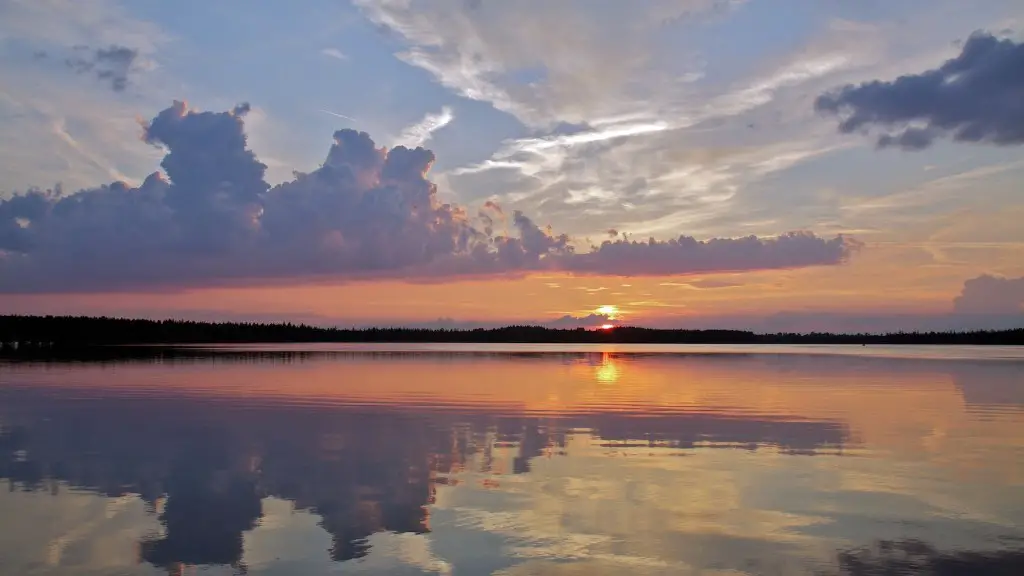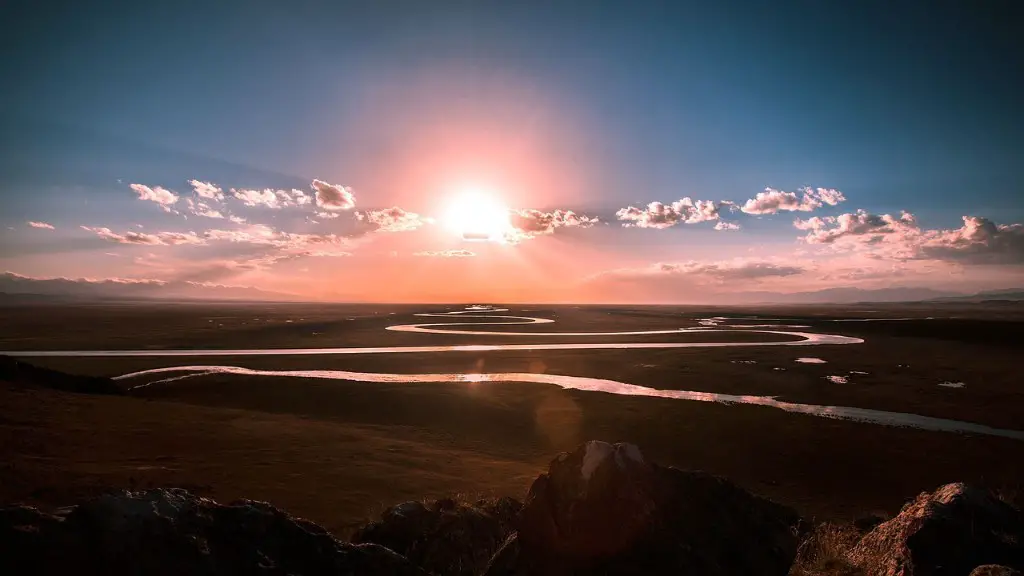The Amazon River is located in South America and is the largest river in the world. It starts in the Andes Mountains of Peru and flows eastward, through Brazil, to the Atlantic Ocean. The Amazon is about 6,400 kilometers (4,000 miles) long and its basin covers an area of about 7 million square kilometers (2.7 million square miles).
The Amazon River starts in the Peruvian Andes and ends in the Atlantic Ocean.
Where does the Amazon river begin and end?
The Amazon River is the largest river system in South America and the second largest in the world by volume of water discharged. It is approximately 6400 kilometers long and up to 6 kilometers wide at its widest point. The river system originates in the Andes Mountains of Peru and travels through Ecuador, Colombia, Venezuela, Bolivia, and Brazil before emptying into the Atlantic Ocean. The Amazon basin covers an area of approximately 7 million square kilometers, about one-fifth of the South American continent. The average depth of the river is about 50 meters, and the maximum depth is approximately 110 meters.
The Amazon River is one of the longest rivers in the world, stretching over 4,000 miles from the Andes Mountains in Peru to the Atlantic Ocean in Brazil. Along its journey, the Amazon River flows through some of the most diverse and unique ecosystems on the planet, providing a home for an incredible array of plant and animal life. The Amazon River and its basin are also of great importance to the people who live there, with many relying on the river for their livelihoods.
Where does the Amazon river get all of its water
The Amazon river has a number of headstream areas, which are the headwaters of three different Peruvian rivers. These rivers are the Marañón, the Apurímac, and the Mantaro. The Amazon river is not considered to have one unique source, but these headstream areas provide the river with its water.
The Amazon is the world’s largest tropical rainforest, spanning eight rapidly developing countries—Brazil, Bolivia, Peru, Ecuador, Colombia, Venezuela, Guyana, and Suriname—and French Guiana, an overseas territory of France. The Amazon is home to an incredible diversity of plant and animal life, including many endangered and threatened species. The rainforest is also an important source of timber and other natural resources, and is increasingly being developed for agriculture and other commercial uses. The Amazon is under threat from deforestation, climate change, and other environmental threats.
Can you swim in the Amazon river?
The Amazon is a vast and diverse place, with many different types of swimming spots to choose from. Whether you’re looking for a relaxing swim in a lagoon or a more adventurous swim in one of the many rivers, there’s something for everyone in the Amazon.
1. The Amazon River originates in Peru.
2. The Amazon River System meanders through nine South America countries.
3. A Slovenian athlete once swam almost the entire length of the Amazon River in 66 days.
4. The Amazon River provides 20% of the ocean’s fresh-water supply.
5. The Amazon River is the largest river in the world by discharge volume.
6. The Amazon River is the second longest river in the world.
7. The Amazon basin is the largest river basin in the world.
8. The Amazon rainforest is the largest rainforest in the world.
9. The Amazon River has more than 3,000 recognized species of fish.
10. The Amazon River dolphin is the largest river dolphin in the world.
11. The Anaconda is the largest snake in the world and can be found in the Amazon River.
12. The Amazon River is home to the largest freshwater turtle in the world, the Arrau turtle.
13. The Amazon River is home to the piranha, one of the most feared fish in the world.
14. The bull shark is one of the
Why is there no bridge on the Amazon river?
This is why there are so few bridges in the Amazon Basin – because there are very few roads for them to connect. The dense rainforest is sparsely populated outside of a few large cities, and the river itself is the main highway for those traveling through the region.
The Amazon rainforest is the largest tropical forest in the world and is home to an incredible array of plant and animal life. More than 30 million people, including 350 indigenous and ethnic groups, live in the Amazon and depend on nature for agriculture, clothing, and traditional medicines. There is also a clear link between the health of the Amazon and the health of the planet. The forest plays a vital role in regulating the Earth’s climate and is an important store of carbon. Deforestation and climate change are major threats to the Amazon and its people.
What 3 countries Does the Amazon river run through
The Amazon flows through some of the most biodiverse regions on earth, providing critical ecosystem services to humans and wildlife alike. The river and its tributaries are home to some 3,000 species of fish, including the giant arapaima, giant otters, piranhas, and electric eels. The river also supports a diverse array of terrestrial wildlife, including reptiles, amphibians, birds, and mammals.
The Amazon and its tributaries provide critical ecosystem services to humans and wildlife alike. The river is a major source of fresh water for millions of people, a transportation corridor for goods and people, and a key source of income for many communities through fishing, agriculture, and tourism. The river also supports a diverse array of terrestrial wildlife, including reptiles, amphibians, birds, and mammals.
The Amazon River is one of the world’s great rivers, but its water is not safe for humans to drink. The river is far too muddy and has too many biological components; a person who drank this water would likely get sick.
Is the Amazon river freshwater or saltwater?
The Amazon River is an important source of fresh water for many countries in South America. The river flows at an amazing rate of 209,000 cubic meters per second, making it the second longest river in the world. The river is a vital source of water for many people and animals in the region.
The dry season in the region historically runs from July to December. However, over the past five years, the droughts have gradually worsened. As a result, the river level has also gone down, making it difficult for boats to travel. Mr. Rufino says that this is a major problem for the people in the region who depend on the river for transportation.
Do people live in the Amazon
The Amazon rainforest is thought to be home to some 30 million people. Of these inhabitants, 16 million are indigenous and belong to more than 400 different indigenous groups. Some of these groups are isolated tribes who choose to avoid contact with the outside world.
The Amazon rainforest is an important environment, both for its inhabitants and for the world at large. The rainforest provides a home for countless plant and animal species, and is vital to global climate stability. Deforestation and other human activity is thought to be putting the rainforest and its inhabitants at risk.
The Amazon River is the largest drainage basin in the world, with an area of approximately 7,000,000 km2 (2,700,000 sq mi). The portion of the river’s drainage basin in Brazil alone is larger than any other river’s basin. The Amazon River is a major river in South America, stretching through Peru, Colombia, and Brazil.
Why is the Amazon river being destroyed?
It is estimated that approximately 17 percent of the world’s forest has been lost in the last 300 years. The primary cause of this loss is clearing for development, including farming, roads, dams, mining, and house-building. This is often seen as more economically valuable than keeping the forest standing. However, the loss of the forest has serious implications for the environment and the wildlife that lives there. We are working to change the perception that it is more valuable to destroy the forest than to keep it standing.
Caimans are a type of alligator that is found in the Amazon rainforest. They can grow to be very large, and the black caiman is one of the largest types of crocodile on Earth. Caimans are interesting creatures that are worth learning more about.
Warp Up
The Amazon River starts in the Andes Mountains of South America and ends at the Atlantic Ocean.
The Amazon River start in the Peruvian Andes and end at the Atlantic Ocean.





